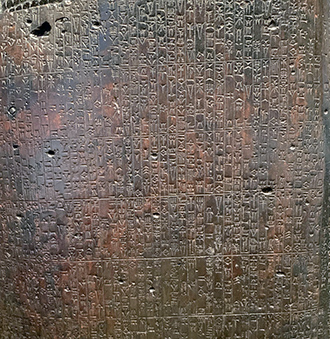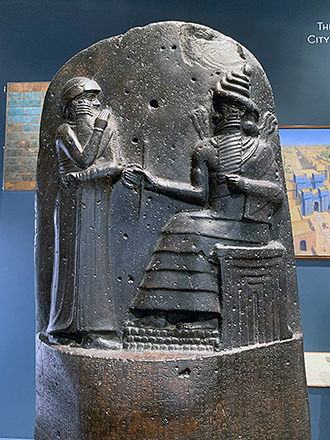在西元前3100年至西元前3300年之间,沿着底格里斯河、幼发拉底河和尼罗河河畔兴起的早期农业文明,发展出政府体制、类都市的大规模城镇和人力的专业分工(complex divisions of labor)与官僚等级(bureaucratic hierarchies)。到了西元前3100年,在埃及境内,所有沿着尼罗河流域,上至北部尼罗河较下游的三角洲,下至南部远达尼罗河上游的区域,皆在法老体制(Pharaonic system)之下统一。几世纪之后,约西元前2334年左右,阿卡德王朝在美索不达米亚城邦的统治者-萨尔贡(Sargon),扩大了他的政治影响力,遍及美索不达米亚大部分的地区。而具有城市化和可能制定法律能力的其他当代文明,则有卡拉尔文明(Caral Civilization )或称北奇科文化(位于现今秘鲁中部海岸)和南亚沿印度河流域所兴起的文明。
Between 3300 and 3100 BC the early agricultural civilizations along the Tigris and Euphrates, and also along the Nile, developed governments, large towns that could be considered cities, and complex divisions of labor and bureaucratic hierarchies. By 3100 BC Egypt all along the Nile, from the lower delta area in the north to the upper areas far to the south had been unified under a Pharaonic system. Centuries later, around 2334 BC, Sargon, the ruler of the Mesopotamian city state of Akkad expanded his political influence through most of Mesopotamia. The only other contemporary civilizations that were urbanized and probably had codes of law at this time would be the Caral Civilization (or Norte Chico Culture) of what is now the central Peruvian coast and the civilization rising along the Indus River in south Asia.
虽然看起来在埃及和美索不达米亚两地,很可能有定期制定、编写和发布法规的文明,不过在众多法典中,较引起历史学家们注意的一部法典是制定于西元前1792年的汉摩拉比法典(the code of Hammurabi),这是一部以书面形式,最早也至今保存较为完整的法典之一,出现的时间是在萨尔贡国王建国500年之后,也是在法老统治下,埃及统一大约1300年之后。
While it seems likely that both the Egyptian and Mesopotamian civilizations regularly established legal codes and had them written and distributed, historians give much attention to one of the earliest codes of law to survive down to the present in written form, the code of Hammurabi, which dates to 1792 BC, a little over 500 years after Sargon established his empire, and approximately 1,300 years after the unification of Egypt under a Pharaoh.
汉摩拉比的法律并不是最早出现的,在乌鲁伊宁基那法规(the rule of Uruinimgina)中幸存下来的法令,甚至可以追溯到西元前2374年左右,是由乌鲁伊宁基那(Uruinimgina)国王在拉格什(Lagash)城邦执政时所制定的,而西元前2100年或西元前2040年左右(年代不确定),乌尔-纳姆国王统治的乌尔、埃里都、乌鲁克和尼普尔等城邦,当时所撰写的乌纳姆法典(Ur-Nammu’s legal codes),也有近一半的法条被保存下来。所以乌鲁伊宁基那法典比汉摩拉比法典早了550多年,而乌纳姆法典也比汉摩拉比法典早了250-300年。
Hammurabi’s laws were not the first. Some rules and laws dating to the rule of Uruinimgina in Lagash around 2374 BC have survived, as have about half of the law codes of Ur-Nammu who ruled over Ur, Eridu, Uruk, and Nippur. Ur-Nammu’s legal codes date to around 2100 BC or 2040 BC (chronologies are not certain). So Uruinimgina’s laws predate Hammurabi’s codes by over 550 years, and Ur Nammu’s codes are 250-300 years earlier than Hammurabi’s.
美索不达米亚有几个不同的民族(ethnic groups),其中有五个比较重要的族群是: · 苏美尔人Sumerians(说苏美尔语,一种与任何其他语言没有链接的语言) · 阿卡德人Akkadians (说东闪族语eastern Semitic language) · 亚摩利人Amorites(来自西北高原,说西闪族语western Semitic language) · 埃兰人Elamites(从高原地区到美索不达米亚的东部,此民族住在苏萨城,当地居民实行男女平等,其语言与其他语言不存在任何亲属关系) · 古提人Gutians (也是来自底格里斯河和幼发拉底河沿岸西北城邦的地区,也是说一种孤立语言language isolate)
Mesopotamia had several different ethnic groups. Five of the significant ones were:
1) Sumerians (who spoke Sumerian, a language without known links to any other language),
2) Akkadians (who spoke an eastern Semitic language),
3) Amorites (from northwestern highlands, and speaking a western Semitic language),
4) Elamites (from highlands to the east of Mesopotamia, who had the city of Susa, who practiced equality of men and women, and spoke a language with no known relationships to other languages), and
5) Gutians, also from areas to the north and west of the city states along the Tigris and Euphrates, and also speaking a language isolate.
汉摩拉比国王是亚摩利人,在世期间是西元前2000至西元前1600年,也是亚摩利人在美索不达米亚最具有影响力和统治地位的时期。汉摩拉比国王的军队击败并摧毁马里、乌尔等国,乌尔的灭亡结束了城邦各自独立的苏美尔文明,并入在汉摩拉比国王统治下,由亚摩利人建立的巴比伦王朝。在巴比伦定居下来的亚摩利人,譬如说汉摩拉比国王,就延用了许多苏美尔文明中的宗教与文化观点,因此,虽然萨尔贡国王的阿卡德帝国统一了各自为政的苏美尔城邦和延续到后来汉摩拉比国王的巴比伦第一帝国(古巴比伦帝国),并没有真正的终结苏美尔文化。
King Hammurabi was an Amorite, and he lived during the period from 2000-1600 B.C. when the Amorites were most influential and dominant in Mesopotamia. King Hammurabi had his armies defeated and destroyed the nations of Mari and Ur, and the destruction of Ur ended independent Sumerian Civilization, which merged with the Amorite kingdom of Babylon ruled by Hammurabi. The settled Amorites such as Hammurabi who lived in Babylon had adopted many of the religious and cultural aspects of Sumerian civilization, so the end of independent Sumerian city states as they were unified in the Akkadian empire of Sargon, and then later the First Babylonian Empire under Hammurabi, was not really an end of Sumerian culture.
汉摩拉比国王算是巴比伦第一王朝(the First Babylonian Empire)中执政最成功的国王,在位时间从西元前1792年到西元前1750年。之后,巴比伦第二王朝(新巴比伦帝国)崛起并历时1100年之久。而圣经中所出现的著名人物亚伯拉罕,时间是发生在巴比伦第二王朝的时代,据说他的家乡在乌尔,不过此乌尔应该是在现今土耳其东南部的尚勒乌尔法(Sanliurfa)或称乌尔法(Urfa),跟巴比伦时期的乌尔城是两个截然不同的地点。
King Hammurabi was the most successful king of the First Babylonian Empire, ruling from 1792 to 1750 BC. There was a second Babylonian Empire that rose to dominance about 1100 years after the days of King Hammurabi and the first Babylonian Empire. It is that second Babylonian empire that figures prominently in the Bible. Also, the best evidence suggests that the Ur mentioned as the home town of Abraham in the Bible was located in what is now Southeast Turkey, and is now called “Sanliurfa” or “Urfa”, and was not the city state of Ur in Mesopotamia.
汉摩拉比国王花了许多年才在军事上取得成功,他直到西元前1762年才完全的征服了邻国,在此之前,巴比伦第一王朝给人的印象并不深刻。在汉摩拉比之前,巴比伦有过五任国王,在汉摩拉比之后,他的继任者只持续了155年的执政,帝国便走向衰败并丧失国土,直到西元前1595年,巴比伦被赫梯人(Hittites)的国王穆尔西里一世(Mursilis I)洗劫一空,最后由赫梯人的盟邦喀西特人(Kassites)接管巴比伦。
The First Babylonian Empire wasn’t an impressive empire until Hammurabi had his military successes, which took him many years to accomplish; as he did not complete his conquest of neighboring states until about 1762 BC. Before Hammurabi, there were five previous kings in Babylon, and after Hammurabi, his successors presided over 155 years of decline and loss of territory until finally in 1595 BC, Babylon was sacked by the Hittites ruled by Mursilis I, and the Hittites handed over Babylon to their allies the Kassites.
汉摩拉比国王在征服美索不达米亚大部分的地区后,宣布了他的法典,里面共有282条法律条文,全文是以楔形文字刻在一块高2.25米的黑色玄武岩上,此石碑现藏于法国巴黎的罗浮宫博物馆(the Louvre museum)。在西元前1160年左右,苏萨(Susa)的埃兰人击败了喀西特人,并将刻有汉摩拉比法典的石碑当为战利品带回了苏萨。虽然这块目前典藏在罗浮宫的著名石碑,有些法律条文被去除掉了(可能是埃兰人所为),不过有很多其他的复制品被找到,在几百年的改朝换代中,法典里面的条文似乎没有很大的变更,法典是以阿卡德语所篆刻出来的,是萨尔贡国王的阿卡德帝国(西元前2334年-西元前2154年)所使用的语言。
After conquering most of Mesopotamia, Hammurabi proclaimed his legal code. There are a total of 282 legal articles in the code. The full text of the code was carved in cuneiform on a black basalt stone 2.25 meters high, which is now in the Louvre museum in Paris. Elamites from Susa brought the stele with Hammurabi’s laws as war treasure when they defeated the Kassites around 1160 BC. Although some of the laws were erased from the famous stele in the Louvre (probably by the Elamites), many other copies of Hammurabi’s legal code have been found, and the laws seem to have endured in successive empires for hundreds of years with little change. The legal code was engraved in Akkadian, which was the language of Sargon and the Akkadian Empire (2334 to 2154 BC).

汉摩拉比法典是以楔形文字刻在石碑上
而在汉摩拉比之后的古巴比伦帝国,可以在楔形文字的泥板上,找到很多法庭上的判决和案例,显然的法院并没有在实际的判决中运用汉摩拉比法典里的法条,法典存在的目的,或许只是用来告示对被定罪之人的罚责之一般原则。汉摩拉比法典有前言(prologue)和结语(epilogue),主要在强调法律是保护弱者免于强者的欺凌,法典里也特别规定了三个等级的社会阶级:绅士或贵族、平民和最底层的奴隶。如果是贵族杀了贵族,惩罚是死刑,如果是贵族杀了奴隶,贵族可以付一笔赎罪金(blood money/price)来补偿奴隶的主人。
There are many court cases and judgements that can be found on cuneiform clay tablets from the First Babylonian Empire after Hammurabi, and from these it appears that the laws of Hammurabi were not applied in actual court decisions. They probably served a purpose of showing general principles of assigning punishments to persons whose guilt was established. The laws of Hammurabi have a prologue and epilogue, which emphasize that the purpose of the laws is to protect the weak from the aggression of the strong. The codes also specify three class levels in society: a gentry or aristocracy, a level of commoner, and an underclass of slaves. If a noble person kills another noble, the penalty is death, but if a noble kills a slave, the noble may offer a blood price to compensate the owner.
汉摩拉比法典在美索不达米亚虽历经了几个世纪,不过少有修改,如同许多法律的制定,合法的为社会中的特权分子和剥削者提供了保留特权,但同时也试图为平民和奴隶阶级者在某种程度上提供了正义和保护,免于不平等的待遇或剥削。因此,政府间处在紧张局势的典型例子,便是一边试图创造社会的稳定并保护权势者的利益,同时也限制士绅的权力,为穷人和被奴役者提供一些保护。尤如许多的法典,包括圣经中的那些法规,汉摩拉比法典的由来也宣称是受到神源的启发,而非纯粹是人为的想像和发明的产物,透由罗浮宫里面这块著名的石碑可看出,最上层的图像呈现了汉摩拉比国王正从坐在宝座之上的太阳兼正义之的神沙马什(Shamash)手中,接受了象征人世间权力的权杖。
Hammurabi’s code endured with few modifications for many centuries in Mesopotamia. Like many laws, it offers legitimacy and a conservative preservation of privilege and exploitation in society, but at the same time it attempts to offer commoners and slaves some degree of justice and protection from unfair treatment or exploitation. Thus, it exemplifies the tension in governments, of trying to create stability and protect the interests of those with power and wealth, while at the same time putting constraints on the powers of the gentry and providing for some protections for those who are poor or enslaved. Like many legal codes, including those in the Bible, the laws of Hammurabi claim to be inspired by Divine sources, and not merely the artifacts of human imagination and invention. The famous stele in the Louvre shows at the top an image of Hammurabi receiving the laws from the sun and justice god Shamash, sitting on a throne and handing to Hammurabi a scepter of earthly power.

图片上所看到的汉摩拉比法典石碑为复制品,展示于芝加哥大学东方研究所博物馆。
|
|


